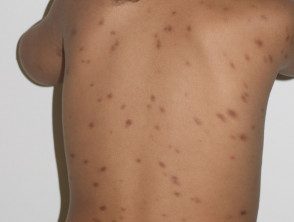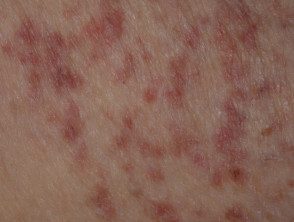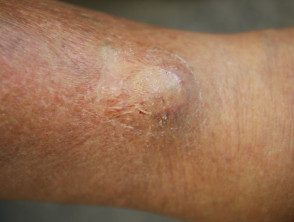What is a hematological disease?
Hematological diseases are a wide range of conditions that affect the constituents of blood. This includes disorders of blood cells (red blood cells, white blood cells, and platelets) and cancer conditions that affect these blood cells. The cutaneous signs of hematologic disease described here are useful for diagnosis and can also cause complications.
Anemia
Nutritional anemia
Anemia can be the result of nutrient deficiencies, for example, iron, B12 or folate.
The cutaneous manifestations are:
- Pallor of the conjunctiva (eyes and palm folds
- Glossitis (smooth red tongue)
- Poikilodermatosus hypopigmentation
- Hyperpigmentation maybe a sign B12 and folate deficiencies
- Fragile nail (koilonychia)
Cutaneous signs of anemia

Iron deficiency itching.

Coilonychia
Hemolytic anemia
Hemolytic anemia, for example, due to sickle cell anemia, results from the destruction of red blood cells, leading to additional symptoms:
- Pruritus
- Jaundice
- Petechiae and hemosiderosis (small brown macules)
Myeloproliferative disorders.
The process by which blood cells are produced (hematopoiesis) gives rise to cells in either one lymphoid or myeloid lineage.
Polycythemia
Polycythemia vera is an example of chronic Myeloproliferative disorder of myeloid cells that causes an increase in the mass of red blood cells.
The cutaneous manifestations are:
- Plethora / Reddish cyanosis (flowery complexion)
- Aquagenic itching (itchy skin caused by contact with water)
-
Erythromelalgia (redness and burning of the hands / feet)
- Livedo reticular (purplish discoloration)
-
Acrocyanosis (bluish-purplish discoloration of hands / feet)
- Pyoderma gangrenous (ulcers)
Cutaneous signs of myeloproliferative disease.

Livedo reticularis

Acrocyanosis
Mast cells disease
Mast cell disease also arises from a myeloid disorder in which mast cells they accumulate in different organs and tissues of the body. This can be broadly divided into cutaneous mastocytosis, which is more common in children, and systemic mastocytosis, which is more common in adults.
The cutaneous manifestations are:
- Maculopapular cutaneous mastocytosis (brown / brown) papules reddish-brown macules and papules in adults). Also know as urticaria pigment
- Darier sign (erythema and hives when you rub the affected skin)
- Pruritus
-
Mastocytomas (rare in adults)
Cutaneous signs of mast cell disease

Maculopapular cutaneous mastocytosis

Mastocytoma

Diffuse cutaneous mastocytosis
Leukemia skin
Leukemia cutis is a rare manifestation of myeloproliferative disease not previously diagnosed or treated and lymphoproliferative disorders, e.g. ex. acute myeloid leukemia (AML), non-Hodgkin lymphoma. Is the result of infiltration of the skin by leukemic cells, resulting in variable papules, nodules and plates. Usually they can be pink, violaceous (purple) or darker than the surrounding normal skin. Also, they are almost always not tender and palpable with a signature, indurated texture.
Leukemia skin

Leukemia skin

Leukemia skin

Leukemia skin
Lymphoproliferative disorders.
Lymphoproliferative disorders arise from disorders of the stem cells of the lymphoid lineage. Systemic forms of lymphoma, Hodgkin lymphoma, and non-Hodgkin lymphoma, can present with cutaneous signs. Specific cutaneous forms of lymphoma are described here.
Cutaneous T cell lymphoma
Cutaneous T-cell lymphoma (CTCL) is a lymphoproliferative disorder that occurs primarily on the skin. The most common form of cutaneous lymphoma is mycosis fungoides.
Manifestations of the skin
- Mycosis fungoides: single or multiple well defined erythematous (Red), scaly macules and patches. Varying in size. Lesions may be orange to dark violet red
-
Sézary syndrome: erythroderma/ exfoliative dermatitis
Associated features include severe itching, hair lost, palmoplantar keratoderma (thickening of the skin of the palms of the hands / soles of the feet) and secondary bacterial infection.
Cutaneous T-cell lymphoma

Sezary syndrome

Mycosis fungoides

Mycosis fungoides tumor stage
Cutaneous Cell B lymphoma
B-cell lymphomas can also present on the skin without evidence of spread to other places at the time of diagnosis. These are known as primary Cutaneous B-cell lymphomas (PCBCL), including primary cutaneous marginal-zone lymphoma. Some of these are Epstein-Barr virus associated lymphoproliferative disorders.
A particularly aggressive form of PCBCL is primary cutaneous large B-cell lymphoma of the leg type. Patients tend to be elderly and have solitary or clustered, ulcerated, bluish, erythematous plaques or tumors located in the legs. This can be misdiagnosed as leg ulcers related to chronic diseases. venous insufficiency.
Cutaneous B-cell lymphoma

Cutaneous B-cell lymphoma

Cutaneous B-cell lymphoma

Cutaneous B-cell lymphoma
Plasma cell and immunoglobulin disorders
Multiple myeloma can rarely present with cutaneous plasmacytoma.
POEMS syndrome presents with polyneuropathy, Organomegaly, Endocrinopathy, Protein M and skin changes. There are plasma cells proliferation and the signs are mediated by the overproduction of cytokines and another inflammatory markers
Cryoglobulins are immunoglobulins that precipitate In cold temperatures. They are palpable purple and hyperviscosity syndrome with Raynaud's phenomenon. Cryoglobulinemia is classified as:
- Type 1 (due to underlying B cell malignancy)
- Mixed (Type 1 + Type II) associated with B-cell malignancy or autoimmune diseases
Cold agglutins are cold-sensitive immunoglobulins directed against antigens in red blood cells. They can lead to Raynaud's phenomenon and acrocyanosis.
Cutaneous signs of plasma cell disease.

Plasmacytoma

Cryoglobulinemia

Acrocyanosis
Amyloidosis
Amyloidosis refers to a group of protein folding disorders where abnormal proteins are deposited in various tissues and organs, including the skin. The most common of these is AL (light chain) amyloidosis.
Manifestations of the skin
- Petechiae (precise red blood spots)
- Pinch of purple (blood stains as a result of stroking the skin)
- Ecchymosis (flat bluish / purplish blood spots, larger than petechiae)
- Waxy hardening of the skin
- Macroglossia (enlarged tongue)
Cutaneous signs of amyloidosis.

Hereditary amyloidosis

Pinch purple

Macroglossia
Hematopoietic stem cells transplant
Transplant stem cells can be obtained from blood, bone marrow, or umbilical cable blood. Hematopoietic stem cell transplantation is an option to treat hematologic malignancies where other treatment options have failed, for example, diffuse Large B-cell lymphoma and myeloproliferative disorders.
Complications of hematopoietic stem cell transplantation can arise from the side effects of immunosuppression or the immune system of the person attacking the “foreign” donated cells (graft versus Host Disease, GVHD). Any organ in the body can be affected by acute or chronic GVHD (eg, liver, lung, joints); however, the skin is affected more frequently.
Manifestations of the skin
- Erythema of palms, plants and ears.
- Bullas
- Eosinophilic folliculitis
- Poikiloderma (thinning of the skin with areas of increase and loss of skin pigment) - chronic GVHD
Extracorporeal photopheresis (ECP) is used to treat cutaneous stem cell GVHD transplant patients
Coagulation disorders
Clotting disorders cause excessive blood clotting or excessive bleeding.
Disseminated intravascular Coagulation (DIC) causes excessive coagulation. It is triggered by a serious infection, such as meningococcal disease, or a disease, such as disseminated. Cancer. Severe DIC can consume all clotting factors, which in turn leads to bleeding.
The cutaneous manifestations are:
- Petechiae
- Ecchymosis
- Bleeding or oozing from wound sites, IV lines, or catheters.
Thrombocytopenia leads to a bleeding tendency. For example, in immune thrombocytopenia, platelet levels are reduced to a varying degree by circulating antibodies Against them. Thrombocytopenia may also be due to bone marrow disease, Wiskott Aldrich syndrome, and drugs.
The cutaneous manifestations are:
- Oral or mucocutaneous petechiae
- Ecchymosis
- Pigmented purple.
Other bleeding disorders with skin signs include:
- Antiphospholipid syndrome
- Warfarin-induced skin necrosis
-
Blue finger syndrome.
Cutaneous signs of coagulopathy.

Meningococcal disease

Disseminated intravascular coagulation
Inflammatory disorders associated with hematologic disease.
The cutaneous manifestations are:
- Generalized hyperpigmentation
- Hemangiomas (tumor of blood vessels)
- Hypertrichosis (excessive hair growth)
- Telangiectasia (like a reddish / purple spider capillaries)
-
Cutaneous vasculitis.
Sweet syndrome (acute febrile neutrophilic skin disease) is an acute inflammatory skin eruption which is accompanied by fevers and leukocytosis. It can be associated with infections, inflammatory bowel disease, hematologic cancers, and certain medications (for example, antibiotics). A located The variant of Sweet's syndrome is known as neutrophilic dermatosis of the dorsal hands.
Manifestations of the skin
- Tender reddish / violet papules or nodules: they can be single or multiple. Injuries may appear bullous, ulcerated or imitates gangrenous pyoderma
- Pustules (pus filled blisters)
- Sensitive erythematous nodules on the extremities (may simulate erythema nodosum)
- Cutaneous pathergy (skin lesions that appear at sites of trauma)
Inflammatory skin disease associated with hematological disease.

Cherry angiomas

Neutrophilic dermatosis of the dorsal hands.

Sweet syndrome
Adverse reactions to drugs
Medications used to treat specific hematologic conditions may have toxicities that manifest in the skin. Examples include:
-
Delayed cutaneous porphyria and vitiligo due to interferon alfa in the treatment of chronic myeloid leukemia (CML)
- Psoriasiform dermatitis, itching, alopecia and photosensitivity because tyrosine kinase inhibitors like imatinib used to treat CML, cutaneous mastocytosis, and sclerodermal GVHD
-
The hydroxyurea puede provocar piel seca, actinic keratosis, scaly cell carcinoma, leg ulcers, hyperpigmentation and nail changes.
Adverse reactions to drugs used in hematology.

Hydroxyurea nail pigmentation

Oral graft-versus-host disease

Cutaneous porphyria delays
